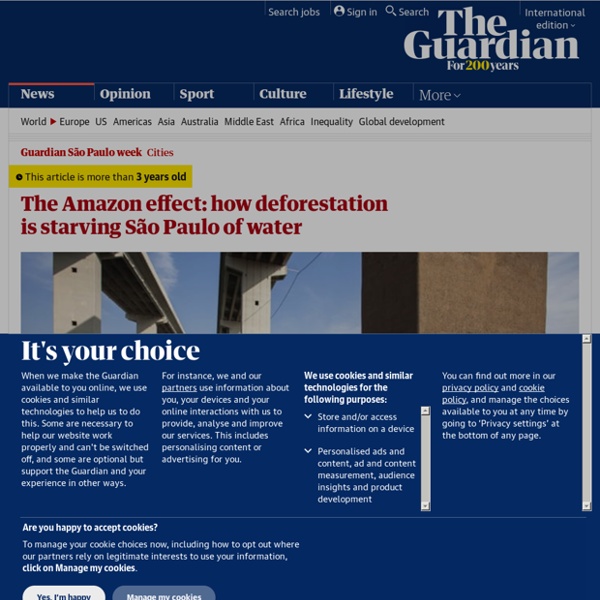Coolgeography - Water and Carbon Cycles
Systems in Water and Carbon Cycles 3.1.1.2 The water cycle Global distribution & size major stores of water Processes driving change in the magnitude of water stores over time and space. Drainage basins as open systems Concept of water balance. Runoff variation and the flood hydrograph. Changes in the water cycle over time 3.1.1.3 The carbon cycle Global distribution, and size of major stores of carbon Factors driving change in the magnitude of Carbon stores over time and space Changes in the carbon cycle over time The carbon budget and the impact of the carbon cycle upon land, ocean and atmosphere, including global climate.
Expansion of agricultural land reduces CO2 absorption
Plants absorb some of the carbon dioxide (CO2) released into the atmosphere by burning fossil fuels. But increasing deforestation and other changes in land use will reduce the CO2 absorption capacity of these areas in the future. This is what a study by climate researchers from Karlsruhe Institute of Technology (KIT) suggests. Their results are now published in Environmental Research Letters. Climate change is heavily related to the increase of CO2 in the atmosphere.
Global Warming, Clouds, and Albedo: Feedback Loops
Water plays a crucial role in many processes that determine our climate. Water also defies our human desire to neatly classify things. When does a water molecule in the air that becomes a droplet in a cloud and then a raindrop that falls into the ocean make its transition from being part of the atmosphere to being part of the hydrosphere?
Explainer: what is carbon capture and utilisation?
Carbon and carbon dioxide are found all around us. All living things contain carbon - it’s one of the essential building blocks of life and is fundamental to many chemical processes. Carbon dioxide (CO2) is produced by respiration and combustion and is used by plants in photosynthesis.
Congo basin’s peaty swamps are new front in climate change battle
Stumbling on submerged roots, attacked by bees and wading waist-deep through leech-infested water, the three researchers and their Pygmy guides progress at just 100 metres an hour through the largest and least-explored tropical bog in the world. The group halt and unpack what looks like a spear, which is plunged over and over again into the waterlogged forest floor. Each time it brings up a metre-long core of rich, black peat made up of partly decomposed leaves and ancient plantlife. The deepest the steel blade reaches before meeting the underlying clay is 3.7 metres. Leeds University forest ecologists Simon Lewis and Greta Dargie cheer.
A new feedback on climate change from the hydrological cycle - Williams - 2007 - Geophysical Research Letters - Wiley Online Library
Abstract [1] An intensification of the hydrological cycle is a likely consequence of global warming. But changes in the hydrological cycle could affect sea‐surface temperature by modifying diffusive ocean heat transports. We investigate this mechanism by studying a coupled general circulation model sensitivity experiment in which the hydrological cycle is artificially amplified. We find that the amplified hydrological cycle depresses sea‐surface temperature by enhancing ocean heat uptake in low latitudes.
Amazon carbon sink is in decline as trees die off faster
Tropical forests are being exposed to unprecedented environmental change, with huge knock-on effects. In the past decade, the carbon absorbed annually by the Amazon rain forest has declined by almost a third. At 6m km2, the Amazon forest covers an area 25 times that of the UK, and spans large parts of nine countries. The region contains a fifth of all species on earth, including more than 15,000 types of tree. Its 300 billion trees store 20% of all the carbon in the Earth’s biomass, and each year they actively cycle 18 billion tonnes of carbon, twice as much as is emitted by all the fossil fuels burnt in the world. The Amazon Basin is also a hydrological powerhouse.
MrC’s Tree carbon content calculator
Where do trees get their mass from? As trees photosynthesise they use sunlight to combine carbon dioxide (CO2) from the atmosphere with water and nutrients from the ground to form carbohydrates which make up the tree’s biomass. CO2 is taken in at a certain rate and builds the mass of the tree over time.
Wetlands Restoration Definitions and Distinctions
What Is Wetland Restoration? In its 1992 report, Restoration of Aquatic Ecosystems, the National Research Council defined restoration as the "return of an ecosystem to a close approximation of its condition prior to disturbance." The concept of restoration is further clarified by defining many types of restoration-related activities. These activities, such as creation, reallocation and enhancement, are similar to restoration, but differ in some way from the process of renewing native ecosystems to sites where they once existed. The holistic nature of restoration, including the reintroduction of animals, is important.
Will the Arctic shift from a carbon sink to a carbon source?
Studies show that the warming of the climate system is altering the movement and storage of carbon in the far north of the Earth. And these changes carry global implications. Among the many questions that scientists such as myself are investigating is whether the Arctic will continue being a net absorber of carbon, or shift to become a net emitter. The Earth’s carbon cycle – the movement and storage of carbon between the land, atmosphere and oceans – is a fundamental element of the climate system.



